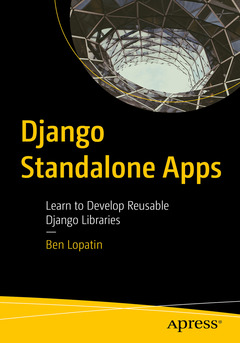Description
Django Standalone Apps, 1st ed.
Learn to Develop Reusable Django Libraries
Language: English
Subjects for Django Standalone Apps:
Keywords
Django; Reusable; Django Pluggins; Django Apps; Web Applications; Python
169 p. · 17.8x25.4 cm · Paperback
Description
/li>Contents
/li>Biography
/li>Comment
/li>
- Scope a standalone Django app project for optimum usefulness
- Extract code from existing projects to reuse
- Test a standalone app outside of your Django project
- Reuse your own code for increased delivery cadence and code quality
- Review best practices for maintaining a Django app package
Chapter 1: Defining the Scope of a Django Standalone App.- Chapter 2: Structuring Django Standalone Apps.- Chapter 3: Testing .- Chapter 4: Model Migrations.- Chapter 5: Templates.- Chapter 6: Using Static Files.- Chapter 7: Namespacing in Your App.- Chapter 8: Creating a Basic Package.- Chapter 9: Scooping and Drawing Boundaries.- Chapter 10: Separating Your App.- Chapter 11: Adding Your App Back In.- Chapter 12: Handling App Settings.- Chapter 13: Internationalization.- Chapter 14: Managing Version Compatibility.- Chapter 15: Mixed Dependency Support.- Chapter 16: Modularity.- Chapter 17: Better Packaging.- Chapter 18: Licensing.- Chapter: 19: Documenting Your Standalone App.- Chapter: 20: Additional Testing.- Chapter: 21: Automating.- Chapter 22: Databases and other backend specific considerations.- Chapter 23: Collaborating.- Chapter 24: Using App Templates.




